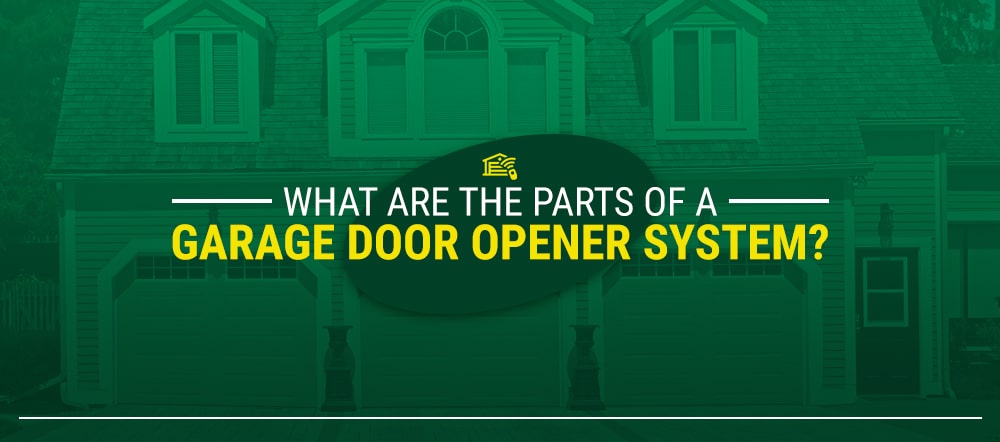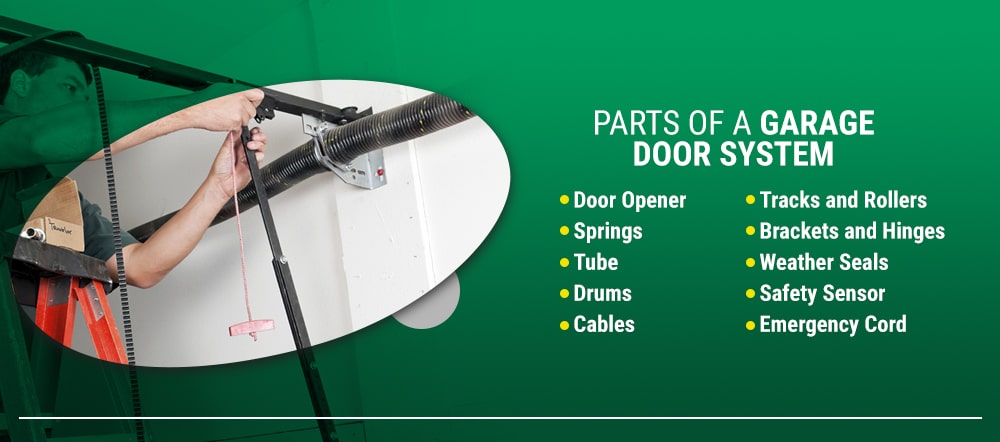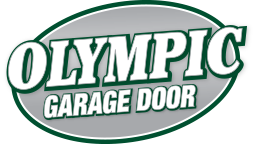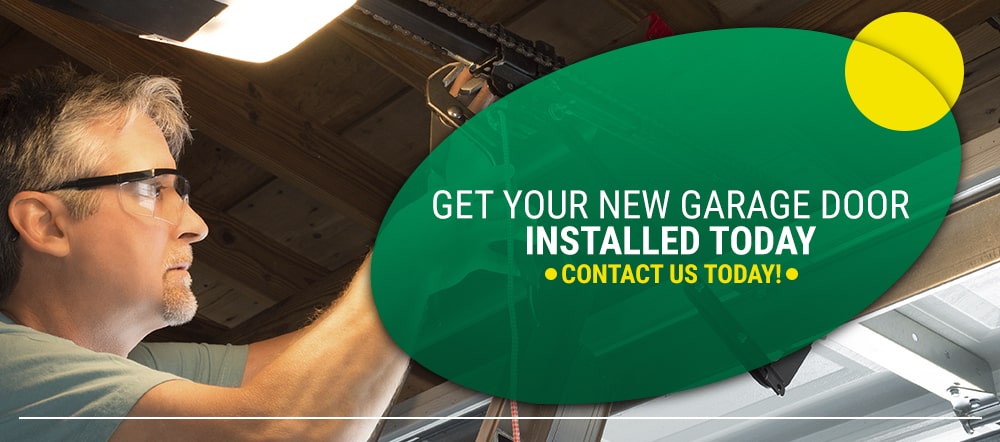What Are the Parts of a Garage Door Opener System?

Garage doors are very convenient appliances. Beyond the fact that they keep your car secure from the elements, most modern doors can be controlled remotely. Despite their convenience, the mechanical elements of a garage door and opener are bound to need maintenance or replacements from time to time. Whether you’re installing a new garage door opener or repairing an old one, you first have to be familiar with the basic parts of the entire system.

Parts of a Garage Door System
So, how does a garage door work? Garage doors aren’t all that complicated in the grand scheme of things. They’re composed of a handful of interconnected parts that perform simple functions on most types of garage doors.
Once you understand the different garage door parts and the functions they perform, you can grasp what causes the door to move up and down, and how. To help you familiarize yourself with the different elements of a garage door and garage door part names, here’s an overview of each of the major parts.
1. Door Opener
Aside from the door itself, the most obvious part of the opening mechanism is the operator. It typically takes the form of a box hanging from the ceiling, with a cord extending to plug into an outlet. The opener is what receives the signal from the switch and remote when you push the button to open the door. It contains the motor, which produces the energy needed to set the mechanism in motion.
2. Springs
Garage doors don’t rely on the motor to produce all the energy needed to lift the door — that would take a lot of power and wouldn’t be the most efficient method. The motor controls the course of the movement, and the placement of torsion springs above the door makes that movement easy.
Springs hold elastic potential energy, which can produce enough power to balance out the door’s weight. That’s why if you lift a garage door manually, you’re not handling anywhere near the full weight of the door.
3. Tube
The tube shaft is the bar running above the door that holds the garage door torsion springs in place. It doesn’t move, but its presence allows the springs to function how they’re supposed to.
4. Drums
The drums are essentially pulley wheels attached to the ends of the tube shaft. When the energy from the springs is released, it causes the drums to rotate. Since the drums connect to the cables, this rotation causes the cables to move.
5. Cables
The connection point between the opening mechanism and the door itself comes in the form of metal lifting cables on each side of the door. The bottom of each garage door cable connects to the bottom of the door, while the top connects to the drum. When the drum rotates, it begins rolling up the cable. As the cables are pulled upward, they lift the door with them.
6. Tracks and Rollers
The garage door components we’ve covered so far lift the garage door. But if that door isn’t kept on a set path, it could crash into the ceiling or go careening off to one side.
Door tracks and rollers keep this from happening. Rollers are essentially small wheels installed along both sides of the garage door. They fit into metal tracks that trace the path the garage door needs to take as it opens and closes. When the mechanism lifts the door, the garage door rollers move along the inside of the tracks to keep the door moving straight up and down. As a safety feature, if your garage door ever comes off this track, it won’t be able to open.
7. Brackets and Hinges
Brackets and hinges both perform a role related to keeping the garage door mechanism connected. Brackets are the metal parts that keep the cables and rollers fastened to the sides of the garage door.
You can find garage door hinges in the middle of the door itself. The door is made up of different door panels so it can fold as it opens, enabling it to transition smoothly from standing vertically to lying horizontally. The hinges are what make this possible, keeping the different panels connected but also allowing them to fold.
8. Weather Seals
The whole point of a garage door is to guard your car and home from the impact of rain, snow, insects and other natural elements. If it doesn’t perform this function, the whole mechanism is ineffective. That’s why garage doors come with weather seals along the sides and bottom of the opening. The door seals bridge the small gap between the door and the walls, insulating the garage from the outdoors.
It’s a good idea to check the weather seals every so often. Unlike the other parts of the garage door, you may not immediately notice if they become damaged. If you do notice, you’ll probably want to replace them with new seals.
9. Safety Sensor
Garage doors are very large and heavy, and they pose a potential safety hazard if not properly monitored. That’s why garage doors come with photo eye safety sensors, which are designed to prevent any accidents.
The photo eye consists of two sensors, one on each side, located on the wall at the bottom of the garage door opening. These sensors face each other, and one sensor projects a beam of light into the lens of the other. As long as this beam is unbroken, the door functions normally. When the second sensor is prevented from detecting the light — which is what happens if something is blocking it — it stops the door from closing.
10. Emergency Cord
Another safety feature is the emergency cord. Though you may have never used it, you’re probably familiar with it. It hangs from the door operator, usually with a red tag at the end to make it stand out. When you pull it, it disengages the opener’s motor.
This feature is useful if you need to perform maintenance on the door without the risk of it opening or closing automatically, or if you need to lift it halfway. You can still lift the door manually with the motor disengaged because the springs will function normally. With the cord pulled, you won’t have to worry about the door moving on its own.
Get Your New Garage Door Installed Today
Are you looking for a new garage door for your home? Olympic Garage Door has your back. We offer garage doors in several different styles and materials, along with top-notch installation service. If you’re looking to repair your old garage door, we’ll do that too!
Just get in touch with us to tell us what you need, and we’ll be happy to help. Or request an estimate today to get started on your new garage door installation.

